Menu
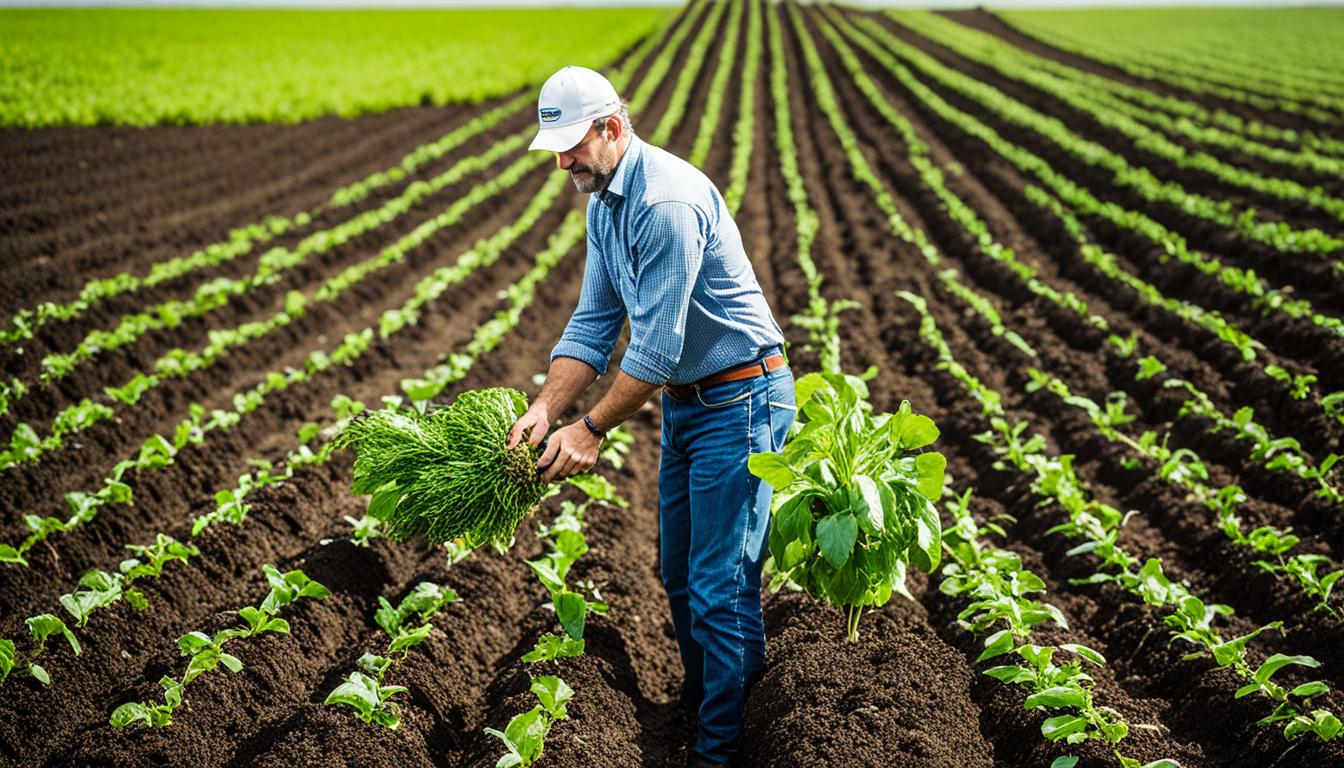
Did you know about 50% of the EU being farmland? This shows how important farming is for soil health. The EU, along with many places, is fighting issues like erosion and loss of biodiversity.
The Natural Resources Conservation Service now offers big help. They give technical and financial support to farmers. This aid is key for improving land, showing a global push to keep soil healthy.
With the CAP 2023-27, the EU is all about sustainable soil use. This plan fits the big goals of the European Green Deal. It focuses on soil health, with a lot of money set aside for projects that help the soil.
It even has tools like FaST for farmers. This tool helps with choosing the right fertilisers. It makes sure farmers follow the laws while also being good for the environment and for the farm’s wallet.
Healthy soil is crucial for farming that lasts. It makes nutrients circulate better, stops soil from washing away, and helps farms handle tough times. Good rules about caring for soil are key. They keep farming productive for years and protect our planet.
Soil erosion is a huge worry for farmers, often washing away valuable soil. It’s shocking that making just one inch of topsoil can take between 500 and 1,000 years. Losing soil to erosion costs U.S. growers a massive $100 million every year. In Arkansas alone, one to five tons of soil are lost from every acre annually because of rain washing it away. To stop this, we must use methods that boost soil health and protect against erosion.
The USDA-NRCS is helping farmers with a program called “Unlock the Secrets in the Soil.” It’s offering money to farmers who use practices that look after the soil. The Arkansas Soil Health Alliance (ASHA) points out that things like growing cover crops and not tilling the soil as much can make soil healthier. They also say it can make farming more profitable, productive, and good for the environment.
Worldwide, many farming rules aim to keep soil healthy. These rules are about keeping soil covered, stopping it from eroding, and saving its natural matter. The Soil Health Institute, set up in 2015, also plays a big role by studying how to keep soil good for growing crops. This work helps make food production sustainable and keeps the environment in good shape.
People worldwide are striving to keep soil healthy. For example, using special farm paths can boost the amount of sorghum we grow, while planting cover crops can reduce the weeds and make our farms better overall. Efforts like these, backed by laws such as the 2022 Inflation Reduction Act, show how important soil care is.
“Improving soil health may not always increase yields but will almost always lead to greater profitability.” — USDA-NRCS
Many programmes are helping farmers take better care of their soil. These include the Conservation Stewardship Program and the Agricultural Conservation Easement Program. They, along with other groups such as the Centers for Disease Control and Prevention, are working hard to keep our planet’s soil healthy.
| Key Statistic | Data |
|---|---|
| Time to form one inch of topsoil | 500 to 1,000 years |
| Global soil loss due to water erosion | 20 to 30 billion tons per year |
| Global soil loss due to wind erosion | At least two billion tons per year |
| Annual farm income loss in the U.S. due to soil erosion | $100 million |
| Soil loss per acre per year in Arkansas | One to five tons (due to water erosion) |
| Expected yield gains in Arkansas | Significant gains in rainfed/dryland systems |
Soil health is a top concern worldwide. This is seen in many laws and rules about farming soil quality. They stress the need to cover soil and to manage lands in sustainable ways.
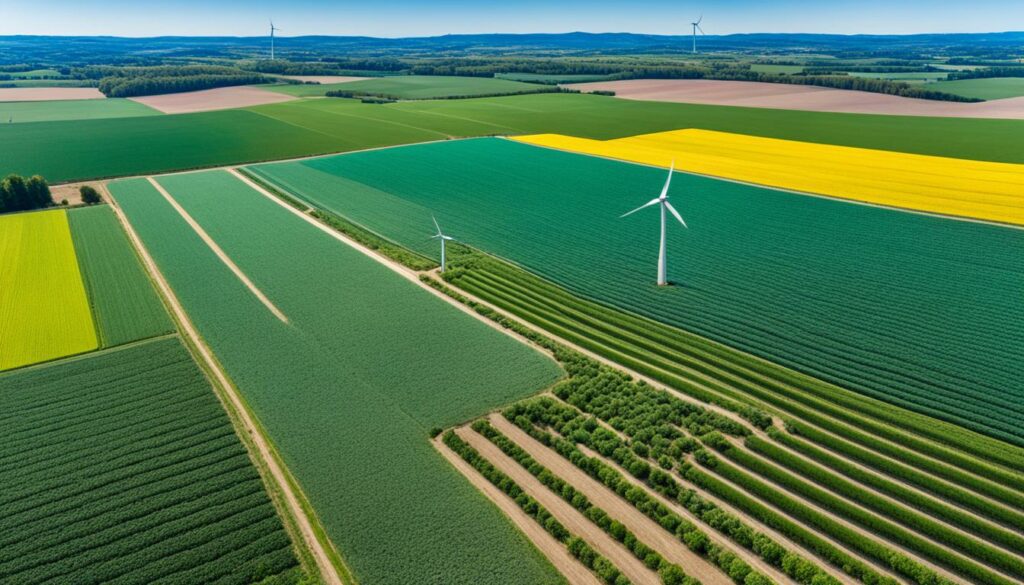
Having enough soil cover is vital. The FAO says good soil cover cuts down on erosion, keeps soil moist, and holds organic matter. This supports soil fertility. Studies in places like Pakistan back this up, showing that soil cover is key for good farming.
Many soil quality rules say we must keep a certain amount of soil covered all year. This reduces erosion and helps keep nutrients cycling. It’s vital for farms to be sustainable.
Good land management is crucial for meeting soil quality laws. Reports show that smart strategies in Asian countries have made a big difference. They’ve made farming more sustainable. Techniques like controlled traffic farming, which helps crops grow better and uses nitrogen well, are part of the success.
In 2021, research found that climate-smart farming improved soil health and boosted crop yields. These methods match the FAO’s aim to improve land care worldwide.
Overall, rules that push for sustainable land use are crucial. They help fight climate change and support a variety of plants and animals. Following these laws ensures farming stays strong and healthy.
To meet global soil health rules in farming, we must follow sustainable agriculture rules. They help us make more food and keep the planet healthy. The work of Arif and Dilawar (2020) shows how these rules stop soil damage and boost farm output.
To stick to these standards, we need to use top farming practices. Assefa et al. (2019) found that using less water and keeping the soil healthy worked well in Africa. Cover crops, as seen in Eash et al.’s (2021) dryland wheat study, also help with water and increase crops. Using these methods makes farms tougher.
Sustainable farming is key to follow soil health rules worldwide. Ball et al. (2018) say linking soil health and people’s health is very important. Brevik and Sauer (2015) highlighted how soil and our health are closely linked. They stress the need for farming practices that help the soil and people stay healthy. Despommier (2018) adds that methods like vertical farming with no soil are also good for keeping the soil healthy and upping food growth.
The use of sustainable farming rules has many benefits. It helps increase the variety of life, fights climate change, and makes sure our food is safe and good for us. Working together on new technology and real farming, like Chávez-Dulanto et al. (2021) research, shows how much we can do for food and soil safety.
Securing soil health is a key goal in the EU, especially under the Common Agricultural Policy (CAP). This policy helps keep our environment healthy while boosting farm productivity.

The CAP is vital for keeping soil healthy over farmlands. It makes sure that soil protection rules are followed. It’s all about making food safely and sustainably because 95% of the EU’s food comes from the soil.
There are many areas the CAP looks at, all working together. They aim to fix issues like unhealthy soil, caused by actions that harm our land. Each year, the EU loses about €50 billion because of soil problems. This shows why we need strong policies now.
One main goal is to agree on what ‘healthy soil’ means and keep an eye on it with a monitoring system. Having the Soil Monitoring Law shows how serious the EU is about this. This law is meant to fight against things that hurt our soil, like erosion and pollution.
By 2023, the EU plans to have all its soils healthy by 2050. They’re focusing on using farmlands wisely and stopping things that damage the soil. This plan fits perfectly with the European Green Deal and its green goals.
The estimated cost of soil degradation in the EU is €50 billion annually, highlighting the critical need for effective soil health regulations.
The Farm to Fork Strategy is a key part of the European Green Deal. It is making agriculture more sustainable and setting high standards. The goal is to change the EU’s food system for the better, helping both people and the planet.
It has a wide-reaching plan that matches the Sustainable Development Goals set for 2030. If we follow these steps, our actions could create over EUR 1.8 trillion in fresh economic value. This shows why it’s so vital to be greener along the food chain.
The plan highlights big aims. This includes cutting down on pesticides by 50%, using 20% less fertiliser, and growing more food organically. These shifts aim to make food production better for the environment and for us to eat.
The effort also looks at big problems like not having enough food. In the EU, about 33 million people struggle to buy enough good food almost every other day. The Farm to Fork Strategy wants to help by making healthy and green food more available, cutting down on food waste as well.
EU farming has already led the way in shrinking greenhouse gases by 20% since 1990. This is a big win because food systems are a main cause of global warming. The work towards sustainable farming is key to fighting climate change and protecting nature.
The strategy also talks about ways to make the change happen. It looks at rules and suggestions to support farmers and those in the food business. Though some plans might be late, new rules for things like fruits, veggies, and eggs as of November 2023 prove their ongoing commitment to greening the food industry.
With the world’s population set to hit 8.9 billion by 2050, sustainable agriculture is vital. We need to double our crop yields using eco-friendly methods. This includes plans to cut pollution to keep our soil healthy for farming.

Keeping our earth clean through farming is crucial. Farming, especially the use of pesticides and chemicals, pollutes a lot. We must manage the soil better to use less harmful chemicals. This approach includes organic farming and careful tilling, which help the soil and cut pollution.
In organic farming, soil’s natural carbon stores are higher than in other methods over the long term. This helps save the environment and supports healthy soil. This is good for growing crops sustainably.
Climate change is a big problem for farming. We must use the soil better to fight its effects. Techniques like strip tillage greatly increase good fungi in the soil. This fungi is key for healthy soil and better plant growth.
The loss of soil life due to overuse is a big issue. We should protect the soil’s creatures by farming in ecological ways. This helps keep the soil rich and able to deal with changing climates.
The collapse of ancient civilisations due to bad farming should warn us of the future. By respecting the soil now, we avoid ruining our resources. So, our future is not in danger.
Agricultural land use policies are crucial for soil conservation and sustainability. Nearly three-quarters of the land changed use between 1982 and 1997, affecting soil quality. This highlights the need for strong international soil fertility regulations to protect our soil.
The CRP in 2005 spent $1.7 billion to leave land uncultivated, similar in size to Iowa. This huge step shows efforts to protect fertile soil. On the other hand, crop insurance, which rose from 90 million acres to 212 million acres, can harm soil quality. This is because it makes it easier for farmers to keep growing crops, even on land that should be resting.
Subsidised crop insurance made cropland grow about 1 percent more in 1997. Yet, much of this new land was prone to erosion, with 33 percent at high risk. Also, 37,000 acres of wetlands were used for farming due to the subsidies. This is a significant amount compared to the total wetland loss in the same years.
Some areas like the Prairie Gateway and Mississippi Portal saw more farmland due to insurance subsidies. Land used for farming because of subsidies often leaks more nitrogen and phosphorus. This harms our water systems and the life they support.
In 2019, Massachusetts launched a special plan for healthy soil. It offers solutions to improve soil health with help from experts. One key idea is to plan soil health care for farming areas. This and other steps aim to maintain soil fertility in the long run.
By investing in soil health, we can expect better water absorption, more control over soil moisture, and healthier growth for crops. The example of Massachusetts shows how international soil fertility regulations can lead to good land use. This can protect our soil and keep it productive worldwide.
Keeping soil healthy is key for farming to be sustainable. A good soil health compliance framework has steps to monitor and assess soil health. This lets us see what’s getting better and what needs work. By focusing on results, not just actions, we use a more lively method of managing our soil. This matches the way farmers are moving towards performance-focused methods.
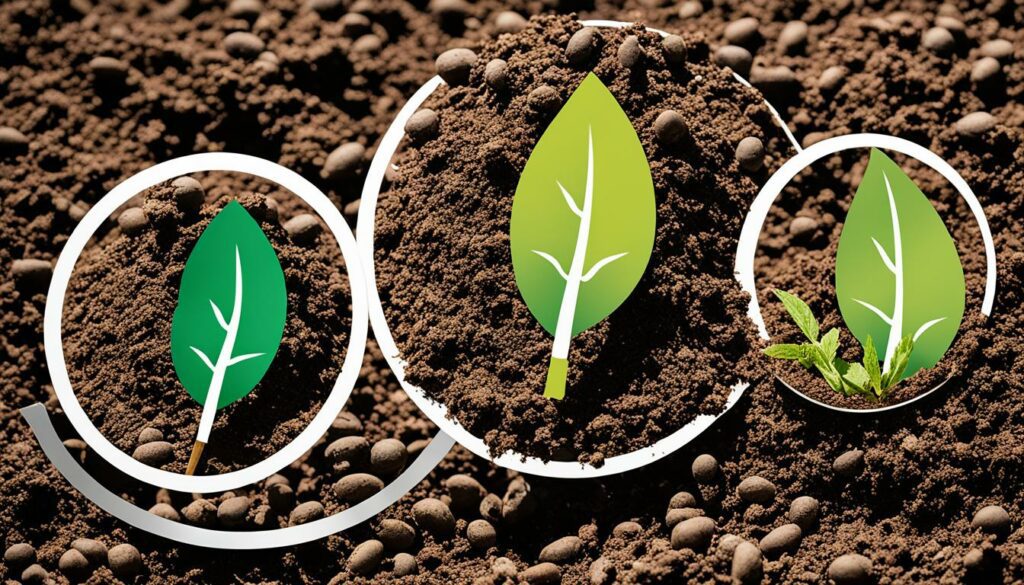
An important part of a soil health compliance framework is keeping a close eye on things. The European Union’s farming rules offer a solid model. They link payouts to farmers with rules about looking after the land, such as making sure the soil is covered and keeping it full of life. The EU’s method for checking on this, with a detailed soil dashboard, means they can keep track of how well farmers are doing.
Having ways to turn checks into ways to do better is key. The US EPA’s Nutrient Recycling Challenge and a Michigan farm programme show how this works. Farmers are encouraged to do things that make the soil better. This includes leaving organic matter, planting cover crops, and changing up what they grow. The EU also lets countries pick the best strategies for their soil. They have tools like the Farm Sustainability Tool for nutrients (FaST) to help out.
By using both strong monitoring and strategies for improvement, the soil health compliance framework keeps soil care moving forward around the globe.
Soil fertility rules are key for global sustainable farming. They guide us on keeping soil healthy through managing organic parts. This helps with making food sustainably and keeping nature in balance.
Taking care of organic parts is vital for soil. It’s proven that using cover crops and rich soil raises what we can grow. A study in Pakistan supported this, showing how important organic is for soil. The FAO also suggests steps to boost soil health, like less erosion and keeping nutrients right. Drip irrigation in Africa using these methods has made water use and soil better.
Biodiversity is a must for good soil health rules. It’s found that farming can be better for everyone through soil and people working together. In Africa, smart farming not only raises crops but also keeps vital soil elements for biodiversity. Using less water and fertilisers while growing grain sorghum means improved soil life. The EU also aims to protect soil for a steady ecosystem.
So, focusing on organic matter and biodiversity is critical in soil rules worldwide. These steps are crucial for meeting global farming health targets. They help us keep farming and nature strong for the future.
The USDA’s Soil Health Programmes are key in guiding good soil management practices in the U.S. They aim to make sure farmers follow rules that protect soil health. This helps them use sustainable methods on their farms.
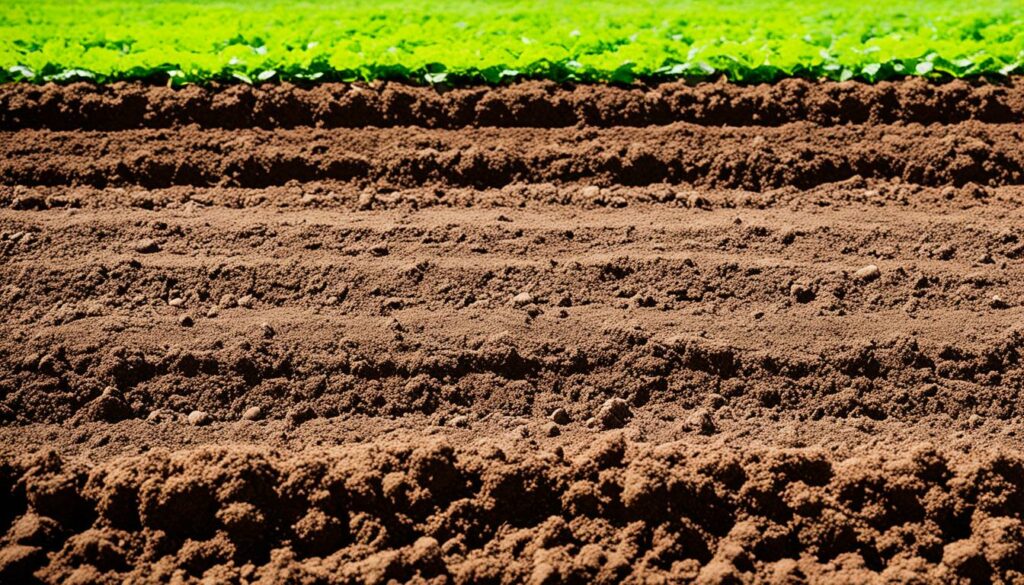
The USDA runs various initiatives to boost soil health in farming. For instance, the Environmental Quality Incentive Program helps farmers with $8.45 billion in funding to use the latest conservation practices.
The Conservation Stewardship Program, with an extra $3.5 billion, looks after more than 70 million acres of land. Together, these programs form an important part of the country’s efforts to keep soil health in check.
Help with money and advice is essential for farmers to keep their soil healthy. Many programmes like the Agricultural Conservation Easement Program, getting $1.4 billion more, are there to assist.
The Regional Conservation Partnership Program, with $4.95 billion, also lends a hand. These efforts show the U.S.’s strong commitment to sustainable farming. The recent $300 million investment, thanks to the Inflation Reduction Act, will further support soil health projects.
California is at the forefront of funding soil health projects. Its Healthy Soils Program has set a good example for other states to follow. Efforts of the Centers for Disease Control and Prevention are also important. They raise community awareness about soil health.
| Programme | Additional Funding (in billions) |
|---|---|
| Environmental Quality Incentive Program | $8.45 |
| Conservation Stewardship Program | $3.5 |
| Agricultural Conservation Easement Program | $1.4 |
| Regional Conservation Partnership Program | $4.95 |
| Conservation Technical Assistance Program | $1 |
| Partnerships for Climate-Smart Commodities | $3.1 |
These actions show the U.S.’s dedication to sustainable farming. By offering help and resources, the USDA ensures farmers can meet important soil health standards. This secures the future health and productivity of their lands.
In soil management, we face many hurdles despite our progress. One main issue is how much agricultural soils suffer. They deal with erosion, lose organic matter, and face contamination and compaction. To help, we need tight rules for managing soil well.
To tackle these issues, we need to check the soil’s condition using specific signs. This approach looks closely at different parts. But, we must also look at how these parts work together. This helps us see what makes soil strong, which is key for its health and our farming future.
Soil is not simple. It’s shaped by its starting materials, the weather, and what we do with it. The work of soil microbes is critical. They adjust how the soil works and help keep it healthy. Microbes are great at handling nutrients, keeping the soil’s structure good, and managing pests.
“Recognising soil as a complex system interacting with broader ecosystems is essential for devising effective soil management strategies,” says Dr. Elaine Ingham, renowned soil microbiologist.
Yet, we still face threats. Things like building cities, cutting trees, and intense farming harm the soil. This leads to erosion and less carbon and nutrients. We must fight this for agriculture and the planet to last. For this, using agricultural sustainability standards and smart soil management regulations is key.
| Challenges | Consequences | Potential Solutions |
|---|---|---|
| Erosion | Loss of topsoil and nutrients | Implement cover crops and contour plowing |
| Soil Compaction | Reduced water infiltration and root growth | Adopt no-till and controlled traffic farming |
| Loss of Organic Matter | Decreased soil fertility and structure | Use organic amendments and crop rotations |
Given these challenges, it’s clear we need strong soil rules and to respect farming limits. Many people, along with knowledge from science, must work together. This is how we break through these difficulties.
The way we farm is changing fast. Now, we’re using global best practices and more sustainable methods to keep soil healthy. We’ve seen big improvements in recent years. These changes are making farming smarter and more efficient through technology.
Precision agriculture is making big changes in farming. It uses GPS and remote sensing to manage fields very carefully. This means we can use fertilisers and pesticides exactly where they’re needed. It saves on resources and is kinder to the environment.
Digital tools are also shaping the future of farming. For example, the Farm Sustainability Tool for nutrients (FaST) is a big step towards sustainable farming. FaST helps farmers use nutrients more efficiently. This means getting more out of crops while following global guidelines.
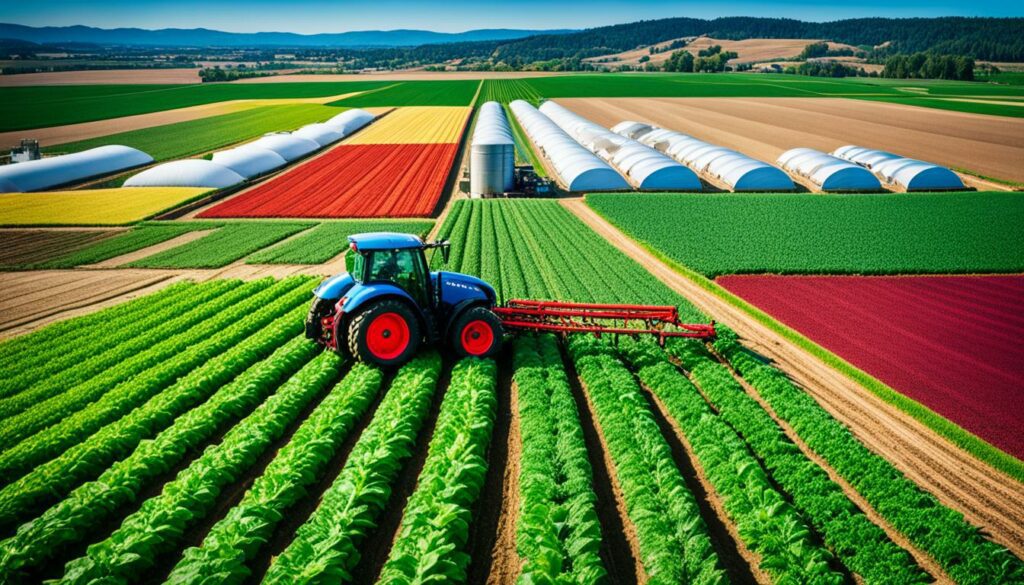
| Theme | Focus | Key Findings |
|---|---|---|
| Nutrient Management and Soil Health | Paper mill biosolids, forest-derived liming materials, humic and fulvic acids, eucalyptus harvest residues | Improved soil properties, metal availability, microbial nutrient mobilization, soil organic carbon content |
| Soil Management and Agricultural Sustainability | Land use alterations, soil organic carbon fractions, soil tillage systems, biochar | Bibliometric analysis of soil health, carbon sequestration, crop production |
| Soil Contamination and Phytoremediation | Cadmium in cacao soils, phytoextraction, arbuscular mycorrhiza | Remediation of soil contaminated with metals, uptake of essential and toxic metals by crops |
| Soil Nitrogen Management and Environmental Impact | Nitrogen budget, statistical entropy analysis | Implications of nitrogen usage scenarios in the Tiber River catchment |
Keeping soil healthy is key for farming worldwide, meeting food needs without harming nature. Global farming’s top tips help improve soil, boosting crops and the earth. These tips mainly cover disturbing the soil less and keeping it covered more.
Less soil disturbance keeps its structure and goodness intact. This leads to better soil health. Recommendations from around the globe include:
Keeping the soil covered is vital too. It shields against erosion, keeps moisture in, and helps life in the soil thrive. Important ways to do this are:
Research globally stresses the value of these good farming methods. Some examples include looking at how to fix low levels of certain nutrients in African soils. This research links better soil health to the food we grow, pointing to ways to make crops healthier.
The push for worldwide soil health rules is a big step for farming’s future. Our Earth’s land has changed a lot from 1990 to 2018, says the FAO. Trends like using cover crops show we’re on the right track.
Work in Sub-Saharan Africa, like using drip irrigation, has made lands more productive. This proves little changes can make a big difference. Techniques like controlled traffic farming and modern methods help crops grow better.
Climate-smart farming boosts crop growth and helps our soil. It’s proven in many big studies. It also stops landslides and makes sure farmers have enough food. The IPBES report shows how science and tech are key to these good changes.
From new ways of farming to checking soil health, we’re moving forward. Following these farming rules means we’ll have good soil for the future. Working together, we can make sure farming is good for our planet and us.
Healthy soil is key for sustainable farming. It reduces erosion and makes nutrients cycle better. This helps farms be more resilient.
Global rules on soil health aim to protect it for farming. They manage land to stop erosion. This keeps the soil rich and supports sustainable food and the environment.
Soil health rules focus on keeping the ground covered and well managed. They aim to keep soil life rich, stop climate change, and help farming last long.
Farmers can meet these rules by using methods that protect the soil. This includes harming the soil less, keeping the ground covered, and adding plants and animals to their fields.
The CAP helps EU farmers produce food safely and sustainably. It lets farmers make a living while looking after the land, which is key to the European Green Deal’s aims.
This strategy is part of the EU’s plan to make farming better for everyone. It aims for healthy food and environment-friendly farming.
These guidelines say farming should not harm the environment. They call for using less chemicals, fighting climate change, and keeping the soil healthy.
These rules protect the soil for farming. They help ensure we can grow food without damaging the land or using too much space.
It has checks and ways to improve how we manage soil. This ensures that farming practices keep getting better for the planet.
These rules focus on keeping soil full of life. They guide farming to protect the Earth’s balance while growing food.
The USDA helps farmers with advice and money for smarter soil use. This includes methods that are good for the land and the farm’s future.
Problems like erosion, soil hardness, and less wildlife are big. They need tackling to keep farming and our planet healthy for the long run.
New tech like precision farming is changing how we care for the soil. It lets us use resources better, which is good for the economy and nature.
To keep soil great for farming, it’s best to touch it less and keep it covered. Adding plants and animals helps, too. It makes the soil more alive and able to grow food well.